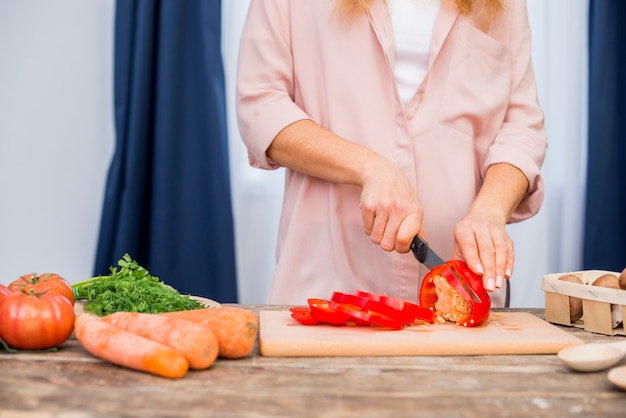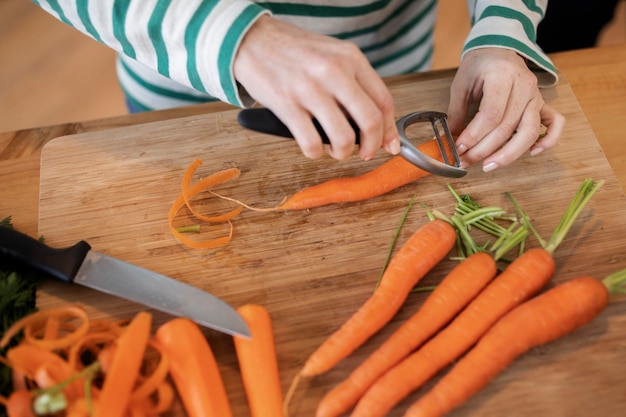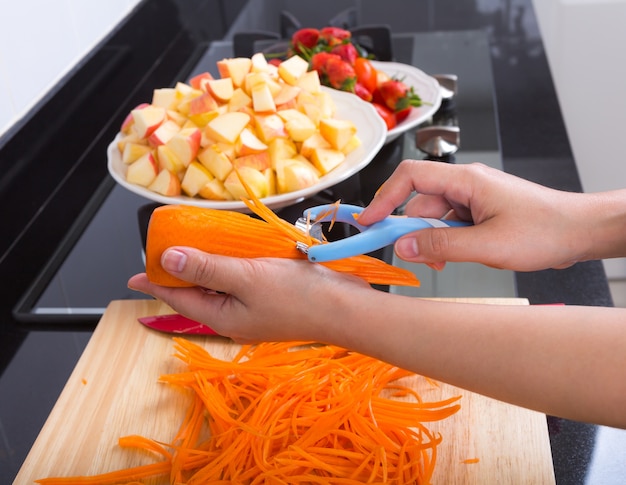I've always loved carrots. From childhood memories of dipping them in hummus to experimenting with different flavour combinations in adulthood, carrots have consistently held a special place in my kitchen. Their versatility is undeniable; they can be enjoyed raw, roasted, or cooked to perfection on the stovetop. Today, I want to share my secrets for achieving the most tender, flavourful, and beautiful stovetop carrots – a journey that goes beyond simply boiling them until they’re soft.
Part 1: Choosing the Right Carrots – The Foundation of Flavour

A good carrot starts with a good selection. Here’s what I look for when choosing carrots for stovetop cooking:
1. Size and Shape: A Matter of Texture and cooking time
The size and shape of your carrots significantly impact how they’ll cook. Tiny baby carrots, with their delicate, bite-sized form, are perfect for quick stir-fries and side dishes where you want them to retain their shape and vibrant colour. They’re ideal for a light, crunchy texture. Larger carrots, on the other hand, are perfect for roasting, stewing, or simmering, allowing them to soften and develop a deeper, richer flavour. They lend themselves to a tender, melt-in-your-mouth experience.
2. Freshness: The Key to Vibrant Flavour and Colour
Freshness is paramount. Look for carrots with bright green tops – a sure sign of vitality. The tops are a great indicator of the carrot's freshness, and they can even be used to add extra flavour to your dishes. Avoid carrots with soft, wrinkled skin, as this signifies that they’re past their prime and won’t yield the best results.
3. Exploring Beyond the Orange: A Rainbow of Flavours and Textures
Don't limit yourself to the traditional orange carrots. Purple carrots, with their vibrant hue and slightly sweet flavour, are a stunning visual addition to any dish. Yellow carrots, on the other hand, boast a milder flavour, perfect for those who prefer a subtler taste. Remember, experimenting with different varieties can open up a world of culinary possibilities and introduce a variety of textures and flavours to your dishes.
Part 2: Preparing the Carrots: The Art of Prepping

Once you've chosen the perfect carrots, it's time to get them ready for cooking. Here's my go-to method for prepping:
1. Scrubbing vs. Peeling: The Benefits of Leaving the Skin On
I'm a firm believer in leaving the skin on unless the recipe specifically calls for peeled carrots. Not only does the skin add a subtle earthy flavour, but it also contains a good amount of fibre and nutrients. A good scrubbing under running water removes any dirt or debris, leaving your carrots ready for cooking. If peeling is necessary, use a vegetable peeler to quickly and efficiently remove the skin.
2. Slicing, Dicing, and Shaping: Customizing your Carrot Experience
The way you slice, dice, or shape your carrots depends entirely on the recipe and the desired outcome. For quick stir-fries, thin slices or julienned carrots are ideal, as they cook faster and maintain their crunch. For stews, larger chunks or even whole baby carrots are great, allowing them to soften and release their flavour into the broth. If you're looking for a beautiful presentation, try cutting the carrots diagonally into thick slices or using a mandoline to create delicate ribbons. These techniques not only add visual appeal but also enhance the overall texture of the dish.
Part 3: cooking techniques: Unleashing the Flavour of Carrots

Now comes the fun part – the actual cooking! Here are some of my favourite stovetop techniques for creating perfect carrots:
1. Simmering: A Gentle Approach to Tenderness and Flavour
Simmering carrots in water is a classic method that yields tender, flavourful results. It’s a gentle approach that allows the carrots to soften and absorb the flavours of the surrounding liquid. Simply add the carrots to a pot with enough water to cover them, bring the water to a boil, then reduce the heat and simmer until they are tender. This method is excellent for preparing carrots for soups, stews, and mashed dishes.
- Adding Flavor: Elevate your simmered carrots with the addition of broth, wine, herbs, spices, or even a touch of sugar to bring out their natural sweetness.
- Timing is Key: Cooking time depends on the size and thickness of your carrots. For baby carrots, 5-10 minutes might be enough. Larger carrots may take 20-30 minutes. Use a fork to check for tenderness. It should easily slide through the carrot when it's cooked.
- Keeping it Bright: To retain the vibrant orange colour of your carrots, add a pinch of sugar or a tablespoon of lemon juice to the cooking water. These additions help to preserve the carrots' natural colour and prevent them from turning dull.
2. Stir-Frying: A Quick and Easy Path to Crunchy Delight
Stir-frying is a fantastic way to cook carrots quickly, maintaining their vibrant colour and satisfying crunch. Heat a wok or large skillet with a bit of oil over high heat, then add the carrots and stir-fry until they are tender-crisp and slightly caramelized. This method is perfect for stir-fries, noodle dishes, and side dishes where you want to preserve the carrots' texture and add a hint of sweetness.
- Getting that Caramelization: Use a high heat and a bit of oil to encourage the sugars in the carrots to caramelize. This creates a delicious depth of flavour and adds a subtle sweetness to your dish.
- Don't Overcook: Stir-fried carrots should be cooked quickly, so watch them carefully and don't let them overcook. Overcooked stir-fried carrots can become mushy and lose their vibrant colour.
3. Sautéing: A Simple Approach to Caramelized Sweetness
Sautéing carrots in butter or oil creates a delicious, slightly sweet, and caramelized side dish. Simply heat butter or oil in a pan over medium heat, add the carrots, and cook until they are tender and golden brown. The heat and fat help to bring out the natural sweetness of the carrots and create a beautiful, glossy finish.
- Seasoning Savvy: Season your sautéed carrots with salt, pepper, herbs, and even a bit of honey or maple syrup for an extra sweetness boost.
- Texture Matters: For a more pronounced crunch, use thinly sliced or julienned carrots. For a softer texture, opt for larger chunks or diced carrots.
Part 4: Carrot Flavour Explosions: Beyond the Basics
While carrots are delicious on their own, adding extra flavour can elevate your dishes to new heights. Here are some of my favourite flavour combinations that highlight the natural sweetness and versatility of carrots:
1. Spice It Up: Warm and Zesty Flavour Combinations
Carrots have a natural sweetness that pairs well with spices. Try adding:
- Ginger: For a warm, zesty flavour, add a bit of grated ginger to your carrots during cooking. The ginger complements the sweetness of the carrots and adds a depth of flavour to your dish.
- Chili: A pinch of red pepper flakes adds a subtle heat that complements the sweetness of carrots, creating a warm and comforting flavour.
- Curry Powder: For a vibrant, fragrant flavour, use a blend of curry powder that includes turmeric, cumin, coriander, and other warming spices. The complex flavours of curry powder blend beautifully with the sweetness of carrots, creating a rich and satisfying dish.
2. Herb Power: Adding Freshness and Aromatic Depth
Fresh herbs can transform your carrots from ordinary to extraordinary. Try using:
- Thyme: Adds a warm, earthy flavour to carrots, enhancing their natural sweetness and creating a comforting, rustic dish.
- Rosemary: Brings a slightly piney, woodsy flavour that pairs well with roasted carrots, especially when combined with other herbs like thyme or sage.
- Parsley: Adds a bright, fresh flavour and a beautiful green colour to your dish. Parsley works well with both raw and cooked carrots, adding a touch of freshness and vibrancy.
- Dill: Offers a unique flavour profile with a hint of anise. Dill pairs well with roasted or sautéed carrots, adding a complex and refreshing element to the dish.
3. Sweet Surprises: Enhancing the Natural Sweetness
The sweetness of carrots can be enhanced by adding:
- Honey: A drizzle of honey adds a rich, golden flavour and complements the natural sweetness of carrots, creating a delicious and balanced dish.
- Maple Syrup: A touch of maple syrup adds a subtle sweetness and a rich, caramel-like flavour, making your carrots more decadent and appealing.
- Brown Sugar: A sprinkle of brown sugar during cooking helps to caramelize the carrots and adds a warm, buttery flavour, bringing out their natural sweetness and creating a beautifully glazed finish.
Part 5: Carrot Creations: Delicious Recipes to Inspire
Now that you've mastered the basics of stovetop carrot cooking, let's dive into some delicious recipes that showcase the versatility of this humble vegetable. These recipes are designed to inspire and spark your own culinary creativity.
1. Carrot and Ginger Soup: A Warm and Comforting Classic
This comforting soup is a perfect way to warm up on a chilly day. The combination of sweet carrots and spicy ginger creates a balanced and satisfying flavour. Simply sauté carrots and ginger, add broth, and simmer until the carrots are tender. Blend the soup until smooth and season to taste. Top with a dollop of cream and a sprinkle of fresh parsley. (See recipe below).
2. Glazed Carrots with Honey and Thyme: A Beautiful and Flavourful Side Dish
These glazed carrots are a beautiful and flavourful side dish that complements a variety of main courses. The honey glaze adds a touch of sweetness and a beautiful shine, while the thyme adds a warm, earthy flavour. Simply sauté carrots in butter, then add honey and thyme. Cook until the carrots are tender and glazed, and serve immediately. (See recipe below).
3. Carrot and chickpea salad: A Refreshing and Healthy Option
This refreshing salad is perfect for a light lunch or a side dish. The combination of crunchy carrots, creamy chickpeas, and a tangy lemon-tahini dressing creates a delicious and satisfying salad. Combine cooked carrots with chickpeas, chopped celery, red onion, and a lemon-tahini dressing. (See recipe below).
Part 6: Carrot and Ginger Soup: A Simple Yet Delicious Recipe
Ingredients:
- 1 tablespoon olive oil
- 1 medium onion, chopped
- 2 cloves garlic, minced
- 1 inch ginger, grated
- 1 pound carrots, peeled and chopped
- 4 cups vegetable broth
- Salt and pepper to taste
- 1/4 cup heavy cream (optional)
- Fresh parsley, chopped, for garnish
Instructions:
- Heat olive oil in a large pot over medium heat. Add onion and cook until softened, about 5 minutes.
- Add garlic and ginger, and cook for 1 minute more.
- Add carrots and broth, bring to a boil, then reduce heat and simmer until the carrots are tender, about 20 minutes.
- Using an immersion blender or a regular blender, blend the soup until smooth.
- Season with salt and pepper to taste.
- To serve, ladle soup into bowls and top with a dollop of cream and a sprinkle of fresh parsley.
Part 7: Glazed Carrots with Honey and Thyme: A Simple and Delicious Recipe
Ingredients:
- 1 pound carrots, peeled and sliced
- 2 tablespoons butter
- 1/4 cup honey
- 1 tablespoon fresh thyme leaves
- Salt and pepper to taste
Instructions:
- Melt butter in a large skillet over medium heat. Add carrots and cook for 5 minutes, stirring occasionally.
- Add honey and thyme, and cook for another 5 minutes, or until the carrots are tender and glazed.
- Season with salt and pepper to taste.
- Serve immediately.
Part 8: Carrot and Chickpea Salad: A Refreshing and Healthy Recipe
Ingredients:
- 1 cup cooked carrots
- 1 (15-ounce) can chickpeas, drained and rinsed
- 1/2 cup chopped celery
- 1/4 cup red onion, chopped
- 1/4 cup fresh parsley, chopped
- Lemon-Tahini Dressing (recipe below)
Instructions:
- In a large bowl, combine carrots, chickpeas, celery, red onion, and parsley.
- Pour dressing over the salad and toss to combine.
- Serve immediately.
Part 9: Lemon-Tahini Dressing: A Tangy and Creamy Dressing
Ingredients:
- 1/4 cup tahini
- 2 tablespoons lemon juice
- 1 tablespoon olive oil
- 1 tablespoon water
- Salt and pepper to taste
Instructions:
- In a small bowl, whisk together tahini, lemon juice, olive oil, and water until smooth.
- Season with salt and pepper to taste.
Part 10: FAQs
Still have questions? Here are some answers to common inquiries about stovetop carrot cooking:
1. What if my carrots are too hard?
If your carrots are still too hard after simmering, you can continue cooking them until they reach your desired tenderness. Alternatively, you can mash them with a fork or potato masher to create a smoother texture, perfect for soups or stews.
2. Can I use different types of broth?
Absolutely! chicken broth, beef broth, or even vegetable broth with added spices can enhance the flavour of your carrots. Experiment with different broths to find your favourite combination. Each broth will impart a unique flavour profile to your carrots.
3. How long can I store cooked carrots?
Cooked carrots can be stored in the refrigerator for up to 3-4 days in an airtight container. They can also be frozen for up to 3 months, making them a convenient ingredient for quick meals.
4. What can I do with leftover cooked carrots?
Leftover cooked carrots are a versatile ingredient! Add them to soups, stews, salads, and even breakfast dishes like scrambled eggs or oatmeal. They can also be used as a base for carrot hummus or a quick carrot and ginger salad.
5. What are some tips for preventing carrots from becoming mushy?
To prevent carrots from becoming mushy, avoid overcooking them. Check for tenderness with a fork, and remove them from the heat as soon as they're tender. Also, use a high heat for stir-frying to encourage caramelization and maintain their crunch. Don’t overcrowd the pan when stir-frying, as this can lead to steaming rather than browning, which can result in mushy carrots.
There you have it! My complete guide to stovetop carrot cooking. Remember, the key to delicious carrots is choosing the right ingredients, using the right techniques, and adding your own creative touches. So get your carrots, get your knives, and get cooking! You'll be surprised at how versatile and delicious this humble vegetable can be.
Everyone is watching

Corn on the Cob: The Ultimate Guide to Perfectly Cooked Ears
Healthy MealsAh, corn on the cob. Just the name evokes images of sunny days, barbecues, and that sweet, juicy flavour that ...

Perfect Pork Roast Oven Cooking Time: A Guide to Delicious Results
Healthy MealsThere's something truly satisfying about a perfectly roasted pork. The aroma alone is enough to make your mout...

Ham Cooking Time: How Long to Bake, Smoke, or Boil a Delicious Ham
Healthy MealsAh, ham. It's a classic, isn't it? A real crowd-pleaser, especially around holidays. And when done right, it'...

Scallops: The Ultimate Guide to Perfect Cooking
Healthy MealsAh, scallops. Those delicate, sweet, and utterly delicious morsels of the sea. They hold a special place in my...

Spaghetti Squash: The Ultimate Guide to Cooking and Serving
Healthy MealsRemember that time you saw spaghetti squash at the supermarket, looking all bumpy and strange, and thought, "W...
